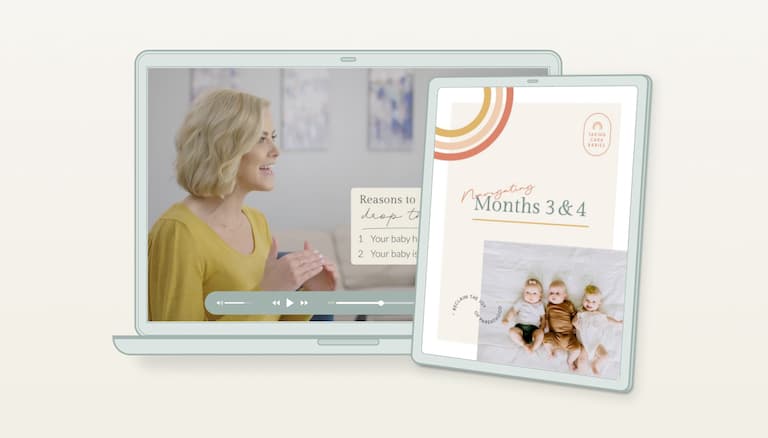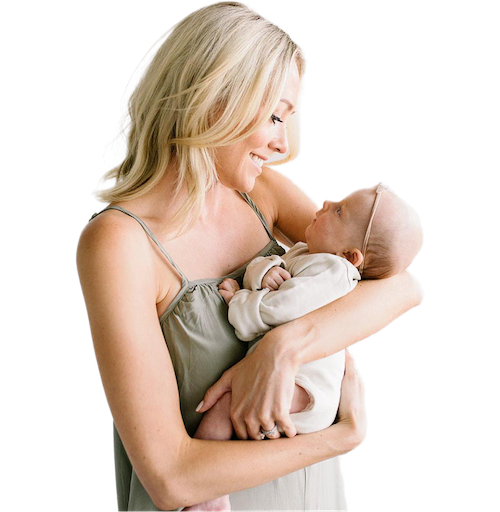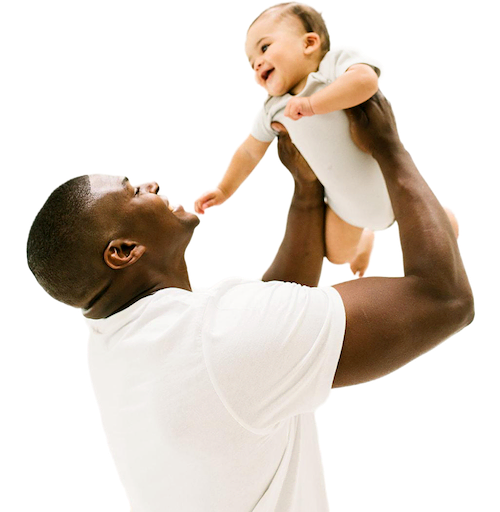Do you have a newborn who takes short naps? You’re not alone. Short naps are SO normal for newborns! Let’s discuss the most frequently asked questions about newborn naps, including if you should swaddle your newborn during the day, how to get naps in the crib or bassinet, and when your baby might start taking longer naps.
What is a short nap for a newborn? Is a 30 minute nap enough for a newborn? anchor
Any nap shorter than the length of an average sleep cycle (about 50 minutes) is considered a short nap. Why? When a nap is longer than 50 minutes, it requires that your baby connect one sleep cycle to the next. So, yes, if your newborn only naps for 30 minutes, that’s a short nap. BUT, short naps are normal and developmentally appropriate in those first several months. Longer naps will come. Please don't let those short naps steal your joy.

First Five Months Bundle
stars ( reviews)
What in the world are parents supposed to do if short naps are normal for newborns? Well, all those "secrets" are available when you take my First Five Months Bundle. I'll teach you how to set your days up for success, work towards longer stretches of sleep, help your baby learn to fall asleep independently, and so much more. I want you to love the newborn stage.
Learn MoreWhy is my newborn taking short naps? anchor
The simple answer: Many newborns simply aren’t developmentally ready to consistently take longer naps.
While short naps are normal and developmentally appropriate for newborns, here are a few culprits that make short naps more likely:
Your newborn is overtired. During the first three months, wake windows are typically between 60-90 minutes (sometimes closer to 35-60 during those first weeks). Following your newborn’s sleepy cues will help you find the wake windows that work best for them. If your baby is flashing sleepy cues or has been awake for 90 minutes, you’ll want to offer a nap to try to avoid overtiredness.
Your baby is not tired enough. We don’t want your newborn to be overtired, but we also want to be sure your baby has been awake long enough to be tired for a nap. If you’re seeing sleepy cues and your baby has been awake less than 60 minutes (for babies 4 weeks or older), try switching up the activity to get them to stay awake just a little longer. Check out my tips for newborn play for some ideas of how to do this.
Your newborn is hungry. Newborns are often very sleepy eaters. I know it can be hard, but keeping your baby awake during feedings can make a big difference. It will make full feedings easier AND allow for age-appropriate wake windows.
Your baby’s nap environment isn’t conducive to sleep. As babies get older, they become more aware of the environment around them, which can disrupt sleep. We want it to be safe, dark (use code Cara for 10% off), a comfortable temperature, and humming with the constant noise from a sound machine (use code CARA20 for 20% off).
Your newborn’s movement during sleep is waking them. Newborns can be very active sleepers. Swaddling your baby until they’re showing signs of rolling can help prevent that active sleep from actually waking your baby. How? Swaddling prevents the jerky movements that are so common in newborns and calms the Moro reflex.
Expert Tip: Sometimes, we actually cause short naps by intervening when newborns are still asleep. Newborns can be noisy and active sleepers, so be sure that your newborn is truly awake before assuming the nap is over.
When do babies start taking longer naps? When do babies consolidate naps? anchor
Babies typically begin to have more consistent and consolidated naps around 5 months of age. Did you catch that? Prior to 5 months, 20-120 minute naps are normal and developmentally appropriate for newborns. I know those short naps can really wreak havoc on your days, especially when trying to follow an eat/play/sleep routine. But short naps are incredibly common in the first few months of your baby’s life. If your baby is 5 months or older and short naps are still a struggle, check out these reasons your baby might be taking short naps.
Naps also tend to become more consolidated and consistent in a sequential order. You may notice that the first nap of the day is the easiest nap for your baby, while that last nap of the day can be a real struggle. If your day allows, aim to practice the first or second nap of the day in the crib or bassinet. For more on how to practice longer naps with your baby, read my tips below.
How do I extend my newborn’s short naps? anchor
Just because short naps are common and developmentally appropriate doesn’t mean you can’t try to lengthen those naps. Here are some strategies you can try to extend your newborn’s short nap:
Replace the pacifier (if your baby takes one)
Rock or hold your baby
Babywear
Now, if you’ve been trying to get your baby back to sleep for 10-15 minutes and it just isn’t happening, that’s okay! Consider the nap over and start your baby’s next wake window. Keep practicing when you can, and remember, those longer naps will come.
My newborn wakes up when I try to put them down for a nap. What can I do?anchor
Your baby fell asleep in your arms and as you lay them down in the crib or bassinet, their eyes pop open! You pick them back up, they fall asleep, you lay them down, and they wake up again! And this cycle repeats. I know how exhausting this can be.
The change from being snuggled against you to laying on their flat sleep surface often causes babies to wake. If you’re trying to lay your baby down as soon as they fall asleep, try waiting a little longer (about 10 minutes) to help them get into a deeper stage of sleep before laying them down.
For more tips to help your baby nap in the bassinet or crib, check out the blog: How Do I Get My Newborn Baby to Sleep in a Crib?
What would a perfect newborn day look like?anchor
Because newborn nap lengths can vary so much (20-120 minutes), there really is no “perfect newborn daytime schedule.”
A hypothetical “perfect" day might look like this:

Text version of Newborn Hypothetical "Perfect" Schedule table
| Time | Activity |
|---|---|
| 7:00 am | Awake & Eat |
| 7:30 am | Play |
| 8:00–10:00 am | Nap (2 hours) |
| 10:00 am | Eat |
| 10:30 am | Play |
| 11:00 am–1:00 pm | Nap (2 hours) |
| 1:00 pm | Eat |
| 1:30 pm | Play |
| 2:00–4:00 pm | Nap (2 hours) |
| 4:00 pm | Eat |
| 4:30 pm | Play |
| 5:00–7:00 pm | Nap (2 hours) |
| 7:00 pm | Eat |
| 7:30 pm | Play |
| 8:00 pm | Bedtime |
| 10:00 pm | Dream feed |
Did you notice that each and every nap in the above schedule was exactly two hours long? This is unrealistic for most newborns.
How do I adjust my day when the day doesn’t go "perfectly"? What do I do if my newborn takes a short nap?anchor
If your newborn takes a short nap (less than 50 minutes), you can:
Try to extend the nap
End the nap attempt and be flexible.
What does it look like to be flexible after a short nap?
Watch your baby and shift your expectations for the day.
Try for the next nap when your baby shows sleepy cues or about 60-90 minutes after the nap ended.
Continue to offer feedings every 2-3 hours according to hunger cues.
Try to do at least one activity between eating and sleeping when you can.
Let’s take a look at how a day of short naps might play out:

Text version of Newborn short nap sample 1 table
| Time | Activity |
|---|---|
| 6:30 am | Awake & Eat |
| 7:00 am | Play |
| 7:30–8:15 am | Nap (45 mins in bassinet) |
| 8:15 am | Awake & Play |
| 9:00 am | Eat |
| 9:15 am | Change Diaper and Swaddle (See how we added a tiny activity to break up eating and sleeping?) |
| 9:20–11:10 am | Nap (110 mins in bassinet - Unexpected gloriously-long nap. Mom got to enjoy a hot shower AND a nap of her own!) |
| 11:10 am | Eat |
| 12:15–12:35 pm | SHORT NAP (20 mins- Mom tried for 15 minutes to get him back to sleep. It wasn't happening.) |
| 12:35 pm | Play |
| 1:40 pm | Eat |
| 1:50–3:00 pm | Nap (70 mins- Fell asleep on mama while eating because he had been up since 12:35 pm. That's okay! NO GUILT! Mom can enjoy those baby snuggles!) |
| 3:00 pm | Play |
| 4:00 pm | Eat |
| 4:15 pm | Change Diaper and Swaddle (He fell asleep while Mom was swaddling him. That's okay!) |
| 4:20–5:20 pm | Nap (60 minutes- 25 minutes in the bassinet, awoke, Mom held him and he slept another 35 minutes.) |
| 5:20 pm | Eat (Cluster Feed: Notice, it has been less than 2 hours since the last feeding, but he showed hunger cues. Cluster feedings are common this time of evening.) |
| 6:00 pm | Play |
| 6:15–6:45 pm | Nap (30 minutes- Fell asleep in bouncy seat) |
| 6:45–7:20 pm | Play |
| 7:20 pm | Eat |
| 7:35 pm | Bath, Jammies, Sing, Swaddle |
| 7:55 pm | Bedtime |
| 10:00 pm | Dream Feed |
(Read all about the “Dream Feed” here.)
Did you see how that schedule was perfectly imperfect? This baby was being offered feedings every 2-3 hours according to hunger cues, and mom did her best to break up eating and sleeping. She offered naps. Sometimes they were long. Sometimes they were short, so she tried to extend them.
Here is another sample. Notice the same principles are being used: offer feedings every 2-3 hours according to hunger cues, break up eating and sleeping when possible, and offer a nap after 60-90 minutes of awake time.

Text version of Newborn short nap sample 2 table
| Time | Activity |
|---|---|
| 6:15 am | Awake & Eat |
| 6:45 am | Play |
| 7:30–8:15 am | Nap (60 minutes- Baby put herself to sleep in the crib. Awoke after 15 minutes, Dad replaces pacifier and rocks baby back to sleep.) |
| 8:15 am | Awake & Play |
| 9:15 am | Eat |
| 9:35–11:00 am | Nap (85 minutes-Baby falls asleep on Dad. Notice it's been 80 minutes that baby has been awake. He swaddles her and baby is still sound asleep. No guilt. Later we'll try to break up the eat/sleep. Dad holds baby for 25 minutes then lays her down in crib. Dad jumps in the shower.) |
| 11:00 am | Awake & Play |
| 11:30 am | Eat (Dad feeds baby early as he has plans to meet a friend for lunch. Baby not showing big-time hunger cues, but still eats well.) |
| 12:00–12:15 pm | Nap (15 minutes- Darn! A really short nap. Baby falls asleep in car seat and wakes up when taken out of the car.) |
| 12:15–1:15 pm | Play (held at restaurant by friend) |
| 1:15–2:30 pm | Nap (75 minutes- Baby fell asleep in car seat while Dad runs errands.) |
| 2:30 pm | Eat |
| 3:00 pm | Play |
| 3:45–4:30 pm | Nap (45 minutes- Baby put herself to sleep in the crib! Watch the newborn class to learn how.) |
| 4:30 pm | Eat (Baby showing true hunger cues and desiring a cluster feeding.) |
| 5:00 pm | Nap (50 minutes- Baby naps for 10 minutes in crib. Dad babywears to extend nap.) |
| 5:50–6:40 pm | Play |
| 6:40 pm | Eat (Baby is a bit fussy and desiring cluster feeding.) |
| 7:15 pm | Play |
| 7:40–8:15 pm | Nap (35 minutes- Daddy wears baby in a wrap, and baby dozes while parents are cleaning up kitchen from dinner.) |
| 8:15 pm | Awake & Play |
| 8:45 pm | Bedtime Routine: Bath, diaper, jammies |
| 9:00 pm | Eat |
| 9:30 pm | Swaddled and put down for the night. (Parents decided no dream feed.) |
The eat/play/sleep routine is fabulous, but short naps are very common with newborns. It’s okay. In fact, it’s more than OK; it’s perfect!
One day may seem like sleep perfection, but the next day can look entirely different. This doesn’t mean that anything has gone wrong; it simply means that your baby is a newborn. Growth spurts, brain development, and all of the important work your baby’s brain and body are doing on the inside keeps them from showing consistency on the outside. Just keep practicing the strategies from the newborn class. You are laying the foundation, and that practice is more important than a perfect schedule each day!
If your baby is out of the newborn phase (13 weeks or older), hope is not lost. I have classes for you too!
Newborn Naps FAQsanchor
-
Prior to 5 months, 20-120 minute naps are normal and developmentally appropriate for newborns. If your baby’s naps are constantly on the shorter end, here are some ways to help extend your newborn’s naps.
-
Yes, I recommend swaddling your newborn for daytime sleep when your baby is sleeping in a crib, bassinet, or play yard. Research shows that swaddling provides a comforting feeling for your newborn and promotes less disrupted sleep. Check out my tips for how to swaddle in the blog: What To Do if Your Baby Hates the Swaddle.
Safety Note: It is not safe to swaddle your baby if they are napping on the go (think: carseat, stroller, carrier/babywearing).
-
When they can be, yes. A dark environment (use code Cara for 10% off) can help for newborn naps. If your newborn is sleeping well in a brighter sleep environment, please don’t stress about making it darker. Just know that as babies get older, light can become quite stimulating. So if sleep starts to look a bit different for your baby, double check their sleep environment.
During awake time, be sure your baby is being exposed to natural light, as this helps correct day/night confusion and gets your baby into a consistent daytime rhythm.
Keep in mind that the information and content on this blog is for informational purposes and should not be considered medical advice. If you have questions about your child, please reach out to your doctor.












